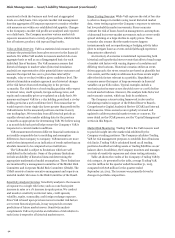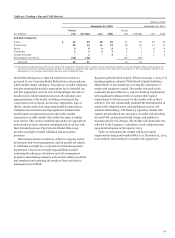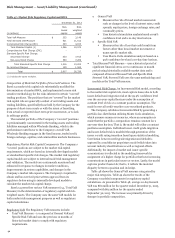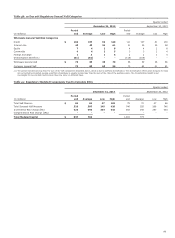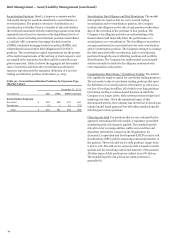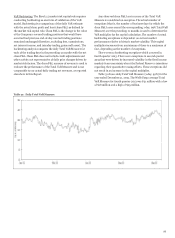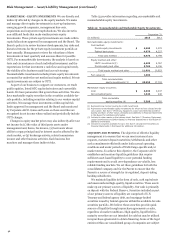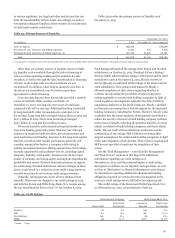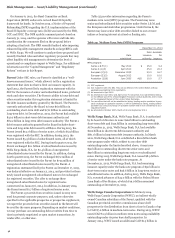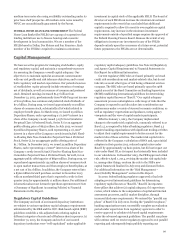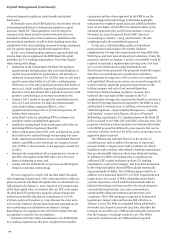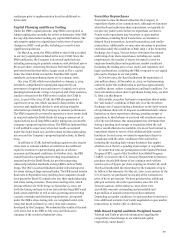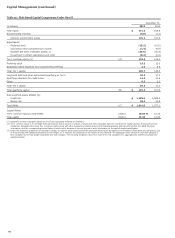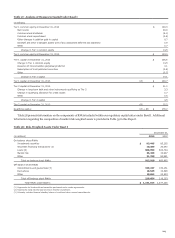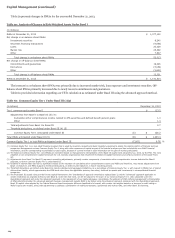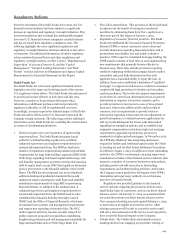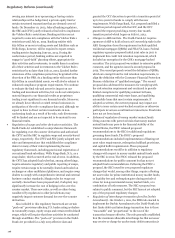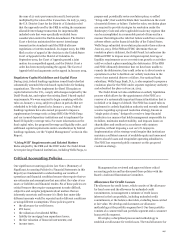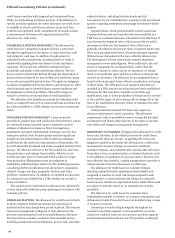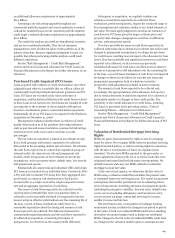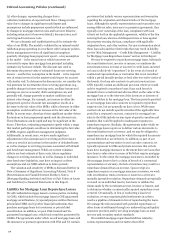Wells Fargo 2013 Annual Report Download - page 102
Download and view the complete annual report
Please find page 102 of the 2013 Wells Fargo annual report below. You can navigate through the pages in the report by either clicking on the pages listed below, or by using the keyword search tool below to find specific information within the annual report.Capital Management (continued)
advanced approach regulatory capital results and related
disclosures.
In December 2010, the BCBS finalized a set of further revised
international guidelines for determining regulatory capital
known as “Basel III.” These guidelines were developed in
response to the financial crisis of 2008 and 2009 and were
intended to address many of the weaknesses identified in the
previous Basel standards, as well as in the banking sector that
contributed to the crisis including excessive leverage, inadequate
and low quality capital and insufficient liquidity buffers.
In July 2013, federal banking regulators approved final and
interim final rules to implement the BCBS Basel III capital
guidelines for U.S. banking organizations. These final capital
rules, among other things:
x
x
x
x
x
x
x
implement in the United States the Basel III regulatory
capital reforms including those that revise the definition of
capital, increase minimum capital ratios, and introduce a
minimum Common Equity Tier 1 (CET1) ratio of 4.5% and a
capital conservation buffer of 2.5% (for a total minimum
CET1 ratio of 7.0%) and a potential countercyclical buffer of
up to 2.5%, which would be imposed by regulators at their
discretion if it is determined that a period of excessive credit
growth is contributing to an increase in systemic risk;
require a Tier 1 capital to average total consolidated assets
ratio of 4% and introduce, for large and internationally
active bank holding companies (BHCs), a Tier 1
supplementary leverage ratio of 3% that incorporates off-
balance sheet exposures;
revise Basel I rules for calculating RWA to enhance risk
sensitivity under a standardized approach;
modify the existing Basel II advanced approaches rules for
calculating RWA to implement Basel III;
deduct certain assets from CET1, such as deferred tax assets
that could not be realized through net operating loss carry-
backs, significant investments in non-consolidated financial
entities, and MSRs, to the extent any one category exceeds
10% of CET1 or all such items, in the aggregate, exceed 15%
of CET1;
eliminate the accumulated other comprehensive income or
loss filter that applies under RBC rules over a five-year
phase in beginning in 2014; and
comply with the Dodd-Frank Act provision prohibiting the
reliance on external credit ratings.
We were required to comply with the final Basel III capital
rules beginning January 2014, with certain provisions subject to
phase-in periods. The Basel III capital rules are scheduled to be
fully phased in by January 1, 2022. Based on our interpretation
of the final capital rules, we estimate that our CET1 ratio under
the final Basel III capital rules using the advanced approach
method exceeded the fully phased-in minimum of 7.0% by
276 basis points at December 31, 2013. Because the rules were
only recently finalized, the interpretations and assumptions we
use in estimating our calculations are subject to change
depending on our ongoing review of the final capital rules and
any guidance received from our regulators.
Consistent with the Collins Amendment to the Dodd-Frank
Act, banking organizations that have completed their parallel
run process and have been approved by the FRB to use the
advanced approach methodology to determine applicable
minimum risk-weighted capital ratios and additional buffers
must use the higher of their RWA as calculated under (i) the
advanced approach rules, and (ii) from January 1, 2014, to
December 31, 2014, the general Basel I RBC rules and,
commencing on January 1, 2015, and thereafter, the risk
weightings under the standardized approach.
In July 2013, federal banking regulators introduced
proposals that would enhance the recently finalized
supplementary leverage ratio requirements for large BHCs like
Wells Fargo and their insured depository institutions. Under the
proposals, effective on January 1, 2018, a covered BHC would be
required to maintain a supplementary leverage ratio of at least
5% to avoid restrictions on capital distributions and
discretionary bonus payments. The proposals would also require
that all of our insured depository institutions maintain a
supplementary leverage ratio of 6% in order to be considered
well capitalized. Based on our review, our current leverage levels
would exceed the applicable proposed requirements for the
holding company and each of our insured depository
institutions. Federal banking regulators, however, have
indicated they may make further changes to the U.S.
supplementary leverage ratio requirements based on revisions to
the Basel III leverage framework proposed by the BCBS in 2013
and finalized in January 2014. In addition, as discussed in the
“Risk Management – Asset/Liability Management – Liquidity
and Funding” section in this Report, a Notice of Proposed
Rulemaking regarding the U.S. implementation of the Basel III
LCR was issued by the FRB, OCC and FDIC in October 2013. The
proposal, which has not been finalized, was substantially similar
to the BCBS proposal but differed in some respects that may be
viewed as a stricter version of the LCR, such as proposing a more
aggressive phase-in period.
The FRB has also indicated that it is in the process of
considering new rules to address the amount of equity and
unsecured debt a company must hold to facilitate its orderly
liquidation and to address risks related to banking organizations
that are substantially reliant on short-term wholesale funding.
In addition, the FRB is developing rules to implement an
additional CET1 capital surcharge on those U.S. banking
organizations, such as the Company, that have been designated
by the Financial Stability Board (FSB) as global systemically
important banks (G-SIBs). The G-SIB surcharge would be in
addition to the minimum Basel III 7.0% CET1 requirement and
ranges from 1.0% to 3.5% of RWA, depending on the bank’s
systemic importance, which would be determined under an
indicator-based approach that considers five broad categories:
cross-jurisdictional activity; size; inter-connectedness;
substitutability/financial institution infrastructure; and
complexity. The G-SIB surcharge is expected to be phased in
beginning in January 2016 and become fully effective on
January 1, 2019. The FSB, in an updated listing published in
November 2013 based on year-end 2012 data, identified the
Company as one of the 29 G-SIBs and provisionally determined
that the Company’s surcharge would be 1.0%. The FSB is
expected to update the list of G-SIBs and their required
100


